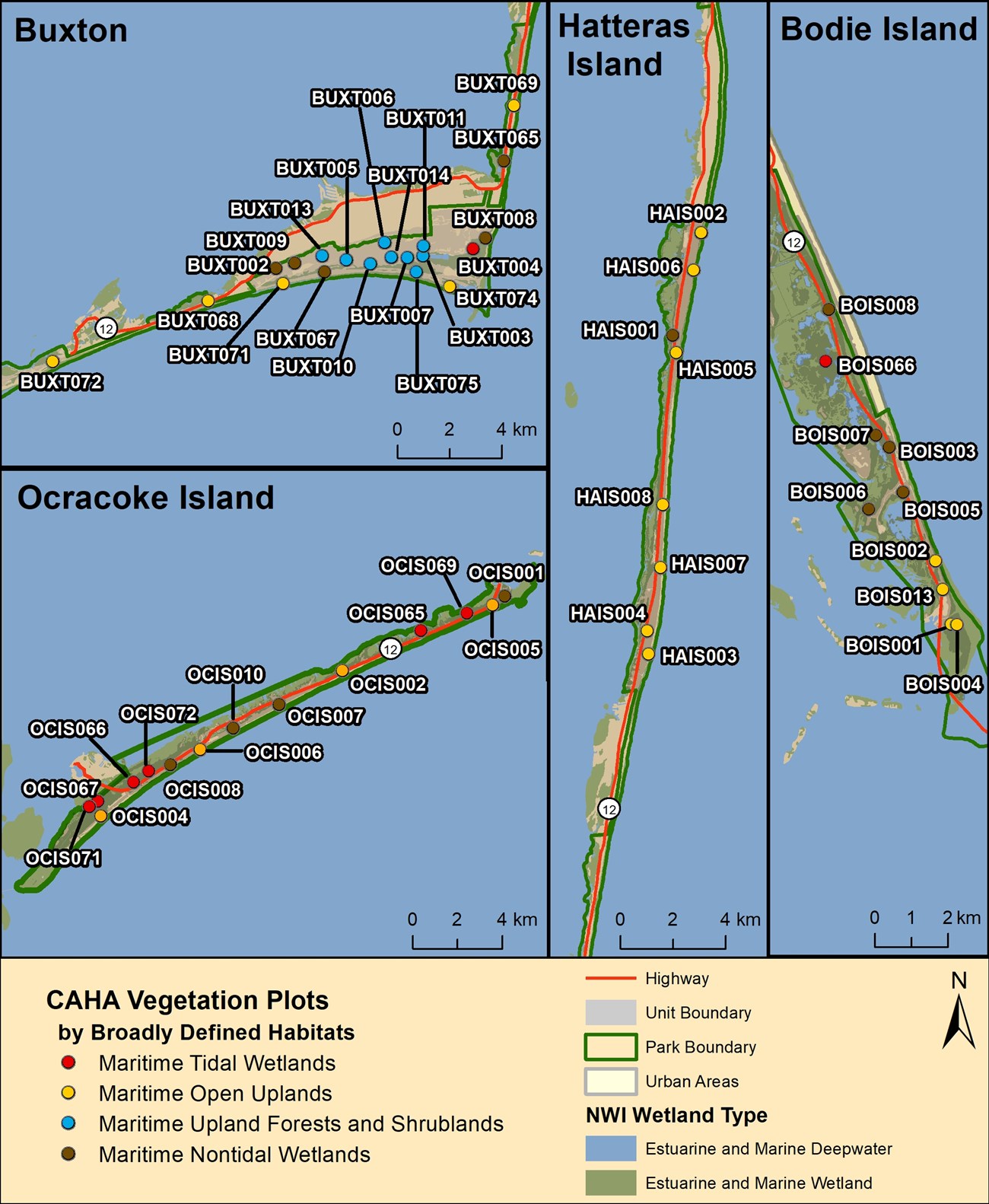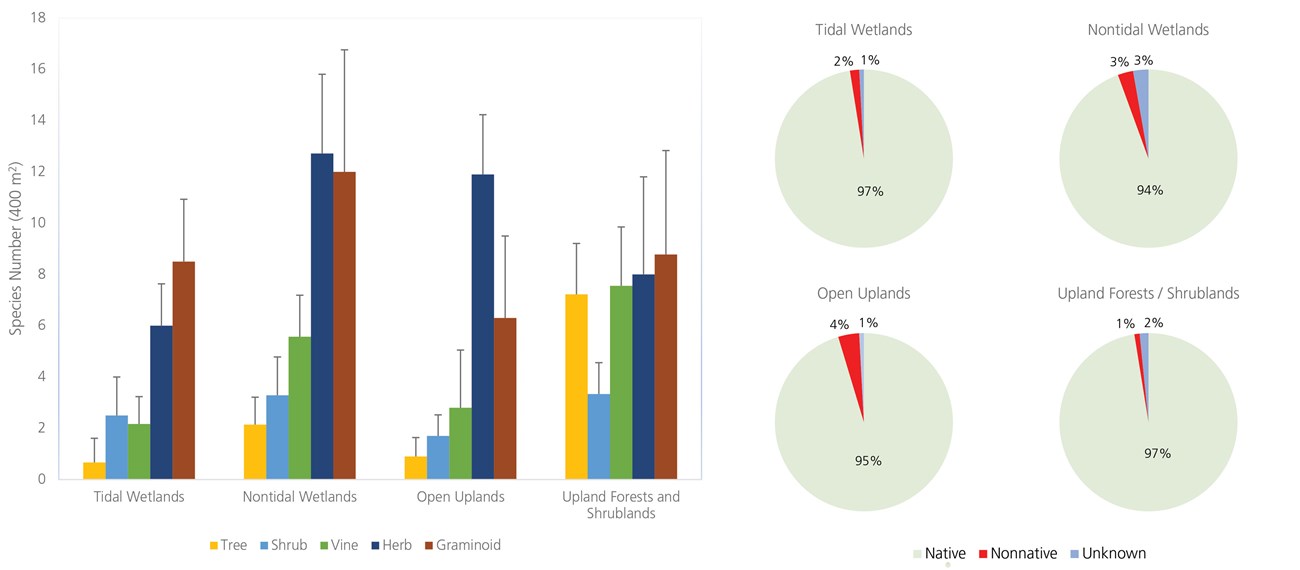Last updated: May 21, 2024
Article
Terrestrial Vegetation Monitoring 2019 Data Summary for Cape Hatteras National Seashore

Overview
Vegetation communities are dynamic entities influenced by environmental factors and impacts from natural and anthropogenic disturbances. The diversity of plants within the southeastern Coastal Plain contributes to a range of ecological services, provides habitat and resources to an array of wildlife, and functions as nature’s backdrop—usually the primary visual cue pulling us toward an appreciation of the outdoors. Determining trends in vegetation communities over time and identifying plant stressors is therefore vital to understanding the ecological health of terrestrial ecosystems within Southeast Coast Network (SECN) parks. Collectively, this information can be used to guide management actions that sustain a park’s ecological integrity and support plant conservation across a diversity of spatial scales for generations to come.
Methods
The Southeast Coast Network collects long-term data on terrestrial vegetation within its parks using a peer-reviewed protocol similar to other NPS Inventory & Monitoring networks in the eastern U.S. and is modeled after the approach used to describe natural vegetation in the Southeast developed by the Carolina Vegetation Survey. Bounded and monumented plots are used to determine a site’s (1) vascular plant richness and abundance for all native and non-native species; (2) woody stem basal area, density and health for all native and non-native species; (3) density of forest floor fuels; (4) community level disturbance events, including presence of insect pests and disease; and (5) abiotic condition (e.g., landform shape, soil nutrients, canopy coverage and height). Plots are randomly located across broadly defined habitat types within SECN parks. Our sampling effort focuses on dominant (> 30% coverage) habitat types within these parks, but when time and resources allow, the sampling effort is increased to include less dominant types. The 2019 Terrestrial Vegetation Monitoring Protocol provides detailed descriptions of field and data processing techniques used by the Southeast Coast Network.
Study Area
Cape Hatteras National Seashore (CAHA) covers approximately 9,903 hectares (24,470 ac) along a 70-mile chain of three barrier islands in eastern North Carolina—Bodie, Hatteras, and Ocracoke Islands. These islands form a substantial portion of the northern Outer Banks and are separated from mainland North Carolina by the Pamlico Sound. Like most barrier islands along the southeastern coast, the vegetation within the park ranges from open beach and foredune grasslands on the ocean side to tidal marshes on the sound side. Between is a mixture of interdune swales and enclosed wetlands. Wide sections within the Seashore—e.g., Buxton Woods—also contain a mixture of upland maritime forest on side slopes and older dune ridges and swamp forest in older dune swales. This protocol was implemented for the first time within the park in 2019, and these data represent the baseline status of vegetation and associated abiotic elements from the following broadly defined habitats of the park: Upland Forests and Shrublands, Open Upland Grasslands, Nontidal Wetlands, and Tidal Wetlands. Fifty-two plots were established across four land parcels of the park (see map).

NPS photo / M. Forbes Boyle.
Significant Findings
Site and Environmental Factors
In the southeastern Coastal Plain, vegetation diversity is influenced by complex edaphic factors and their relationship with site hydrology and disturbance patterns (e.g., fire, storms). At Cape Hatteras National Seashore, these environmental conditions were observed in the landform, soil, and disturbance data collected from vegetation plots. Soil pH values ranged from 4.8 (acidic) to 8.4 (slightly alkaline) and complex topography was evident within ridges and swales of both young and old dune systems. Cape Hatteras National Seashore ecosystems have always been subjected to high frequencies of wind-, tide-, and wave-driven processes that sculpt vegetation composition and structure. Natural and human-caused disturbances affecting plants within other SECN parks—such as high herbivory rates, historical plowing, fire effects, and altered hydrology—were not observed within these plots during this survey effort.
Vegetation
A total of 265 plant species were observed across all plots, including 13 taxa not detected in previous plant surveys and 18 species listed as rare by the North Carolina Natural Heritage Program. Rare species were encountered throughout all habitats surveyed within the park but were most frequently observed in Nontidal Wetland habitat. Overall plot level plant richness ranged from 5 to 47 species, with graminoid and herbaceous plants providing the highest diversity within all broadly defined habitats. Non-native species were encountered in all habitats monitored but their highest frequency occurred in Open Upland vegetation types (e.g., foredunes). Nontidal Wetlands had the highest occurrence of invasive species categorized as Rank 1 and 2 by the North Carolina Native Plant Society (e.g., alligatorweed, Japanese stilt-grass, Japanese honeysuckle, and common reed). Forested habitats within the park were dominated by a combination of red cedar, live oak, loblolly pine, and Darlington oak.

Other Findings
- One hundred percent of the live swamp (Persea palustris) trees measured in these plots were experiencing declining vigor and observed with symptoms like those caused by laurel wilt disease (LWD). To date, LWD has not been confirmed within Dare County, North Carolina
- All plots are scheduled to be resampled in summer 2023.
Full Report
The full report for Terrestrial Vegetation Monitoring at Cape Hatteras National Seashore 2019 Data Summary
About the Southeast Coast Network
In 1999, the National Park Service initiated a long-term ecological monitoring program, known as “Vital Signs Monitoring,” to provide the minimum infrastructure to allow more than 270 national park system units to identify and implement long-term monitoring of their highest-priority measurements of resource condition. The overarching purpose of natural resource monitoring in parks is to develop scientifically sound information on the current status and long-term trends in the composition, structure, and function of park ecosystems, and to determine how well current management practices are sustaining those ecosystems.
The NPS Vital Signs Monitoring Program addresses five goals for all parks with significant natural resources:
- • Determine the status and trends in selected indicators of the condition of park ecosystem,
- • Provide early warning of abnormal conditions,
- • Provide data to better understand the dynamic nature and condition of park ecosystems,
- • Provide data to meet certain legal and Congressional mandates, and
- • Provide a means of measuring progress towards performance goals.
The Southeast Coast Network (SECN) includes eighteen administrative areas containing twenty park units, fifteen of which contain significant and diverse natural resources. In total, SECN parks encompass more than 184,000 acres of federally-managed land across North Carolina, South Carolina, Georgia, Alabama, and Florida. The parks span a wide diversity of cultural missions, including four national seashores, two national historic sites, two national memorials, six national monuments, two national military parks, as well as a national recreation area, national battlefield, national historical park, and an ecological and historic preserve. The parks range in size from slightly more than 20 to nearly 60,000 acres, and when considered with non-federal lands jointly managed with the National Park Service, the network encompasses more than 253,000 acres.
For More Information
SECN Home Page
https://www.nps.gov/im/secn/index.htm
SECN Reports & Publications
https://www.nps.gov/im/secn/reports-publications.htm
About the NPS Inventory & Monitoring Program
https://www.nps.gov/im/index.htm
Data Downloads via the Natural Resource Information Portal
https://irma.nps.gov/Portal/
